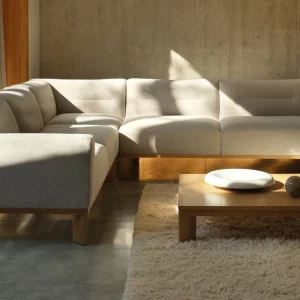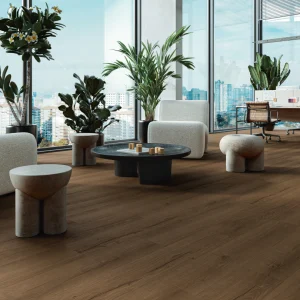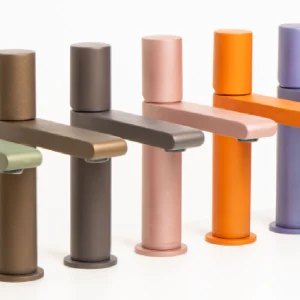
Today sees the opening of Vola’s first London showroom, on Great Portland Street, W1. It has been forty years since Arne Jacobsen and Verner Overgaard designed the original, much-beloved Vola tap for the Danish company, yet the aesthetic of that first product remains a guiding influence. On a visit to the company’s HQ, Vicky Richardson, however, finds that craft and innovation are more important than nostalgia
Jutland in January is bleak. The plane flies in to Billund, notable only as the home of Lego, and a toy village flashes past just before touch down. A 45-minute drive across flat glacial farmland brings me to a strung-out industrial estate just outside Horsens in the east of the province. Here a sign on a brand new concrete building reads Vola Academy. Next door are the factories where the Vola tap, designed by Arne Jacobsen and beloved of architects the world over, has been manufactured for 24 years.
The prototype for the Vola fittings was produced in 1968 and the following year the product had its first outing at the National Bank of Denmark in Copenhagen, also designed by Jacobsen. The name comes from the initials of Verner Overgaard, the product’s engineer who is often overlooked (the L and A derive from Lund A/S, Overgaard’s manufacturing business). In fact, it was Overgaard’s idea to create a tap that had concealed pipes and plumbing. He took the challenge to Jacobsen and between them they created a classic that has been copied endlessly, and, say some, has not been improved upon.
Vola is now a tap empire run by Overgaard’s sons Poul and Carsten, both of whom have worked in the family business for more than 40 years. They stress that the company is independent from foreign capital, which means it can be ‘free-willed’. In fact the brothers’ influence can be felt everywhere, from the ventilated smoking booths where they chat with employees to the digital golf simulator and garages for their vintage cars.By visiting head office I’m hoping to learn something about the aura that surrounds Vola: there’s no doubt that it is a beautiful and universal product, but I half suspect that the ongoing popularity of the design with architects is based on Modernist nostalgia – a form of conservatism. I’m not convinced that a product designed 40 years ago can still be appropriate for today.

On a more selfish note I’m keen to briefly leave behind the imploding British economy with its emphasis on marketing, PR and finance, to embrace the practical business of manufacturing. But they don’t let me near the factory on day one. Instead, I get the marketing spiel. I’m told how Vola is taking the opportunity of its 40th anniversary to restate its brand values for today’s lifestyle – stuff that I’ve heard from countless manufacturers who have paid lots of money to trend forecasters to be told that the consumer desires products for ‘cocooning’, ‘personalisation’, and ‘wellness’. The final disappointment is to hear that after running a focus group, Vola decided its marketing – elegant technical drawings of the fittings on a black background – was too clinical, and its latest advertising campaign will be more ‘emotional’. What would Jacobsen or Overgaard, with their emphasis on functionalism and new technology, have made of this, or indeed the company’s new ‘wellness’ advert which features a naked girl with her hair rippling in water?
This question hangs in my mind as I travel 50km to Aarhus where Jacobsen won a competition to design the City Hall at the age of 35. His design, a severe steel-framed building with a regular grid of square windows, was controversial and the young Jacobsen was forced to compromise by cladding the stark form with Norwegian marble instead of cement plaster, and adding a clock-tower which he regarded as an unnecessary and, worse still, anti-democratic symbol. By the time Jacobsen had designed the Vola fittings, he had already created his most famous pieces of furniture and despite the sculptural exuberance of designs such `as the Swan, Egg and Ant chairs, the fittings, painted the colour of a January sky – concrete grey – had the subdued quality of Arhus City Hall. A display at the Academy shows that you can still buy the tap in the original colour. In fact the success of Jacobsen is that, despite the severe formality of his architecture, his design objects can be revived endlessly in different materials and colours – in their most bizarre incarnation the Egg and Ant chairs define a new look for McDonalds.
But the highlight of my visit is the Vola factory tour. While the Academy looks and feels like the result of a marketing exercise – design at its most self-conscious – the factory throbs with technology and craftsmanship. The place is as clean, if not cleaner than a bathroom. The 180 workers are kitted out in stylish black uniforms with a drawing of the Vola tap on their backs in grey. It’s all extremely tasteful and high-tech, with all the messy drilling of brass and steel contained within brand new Japanese milling machines. Robots do the nasty jobs and lift the heavy matt-black boxes (some workers are in their 60s after a lifetime of service). But craft plays its part too and brushed stainless steel is still hand-finished so that no two products are the same. The Overgaard brothers insist that the original design has not been bettered, but behind the scenes they are making constant improvements to the production process. They can manufacture taps so fast now that they keep very little stock and make most fittings to order. A tap ordered in Munich before 11am can be delivered the same day.
In the coming months Vola will be one of the first companies to manufacture brass fittings that have no lead content (the acceptable level is 3%). This presents a challenge because the lead greases the machinery, however the brothers are confident that this innovation will put the company one step ahead of consumers. It’s these kind of innovations that mean Vola is still interesting and the products remain remarkable in their engineering. The Overgaard brothers have done the hard work: it will be up to the next generation of designers to improve on Jacobsen’s design, while they enjoy a round of golf.





